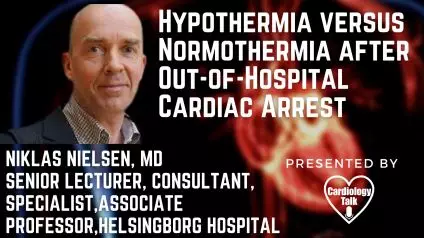Niklas Nielsen, MD - #HelsingborgHospital #CardiacArrest #Cardiology #Research Hypothermia versus Normothermia after...
Niklas Nielsen, MD - #HelsingborgHospital #CardiacArrest #Cardiology #Research Hypothermia versus Normothermia after Out-of-Hospital Cardiac Arrest
Link to Abstract: https://www.nejm.org/doi/full/10.1056/NEJMoa2100591
Abstract
BACKGROUND
Targeted temperature management is indicated for patients who have suffered a cardiac arrest, however the evidence for this is inconclusive.
METHODS In an open-label trial with blinded outcome assessment, we randomly assigned 1900 adults in coma who had an out-of-hospital cardiac arrest of suspected cardiac or unknown cause to targeted hypothermia at 33°C followed by controlled rewarming, or targeted normothermia with early fever treatment (body temperature, 37.8°C). At 6 months, the primary outcome was death from any cause. Functional result at 6 months, as measured by the modified Rankin scale, was a secondary endpoint. Sexe, age, initial cardiac rhythm, time to return to spontaneous circulation, and presence or absence of shock on entry were all used to create subgroups. Pneumonia, sepsis, hemorrhage, arrhythmia resulting in hemodynamic compromise, and skin issues connected to the temperature management device were all pre-specified adverse events.
RESULTS The primary outcome was assessed in a total of 1850 individuals. At 6 months, 465 of the 925 hypothermia patients (50%) had died, compared to 446 of the 925 normothermia patients (48%) (relative risk with hypothermia, 1.04; 95 percent confidence interval [CI], 0.94 to 1.14; P=0.37). 488 of 881 patients in the hypothermia group (55%) had moderately severe impairment or worse (modified Rankin scale score 4) compared to 479 of 866 patients in the normothermia group (55%) who had moderately severe disability or worse (modified Rankin scale score 4). (relative risk with hypothermia, 1.00; 95 percent CI, 0.92 to 1.09). In the predetermined subgroups, the results were consistent. Arrhythmia resulting in hemodynamic compromise was more common in the hypothermia group (24 percent vs. 17 percent, P0.001) than in the normothermia group. The incidence of additional adverse events did not differ significantly between the two groups.
CONCLUSIONS
Targeted hypothermia did not reduce the risk of death in patients in coma following out-of-hospital cardiac arrest by 6 months when compared to targeted normothermia. (TTM2 ClinicalTrials.gov number: NCT02908308. opens in new tab; funded by the Swedish Research Council and others.)




